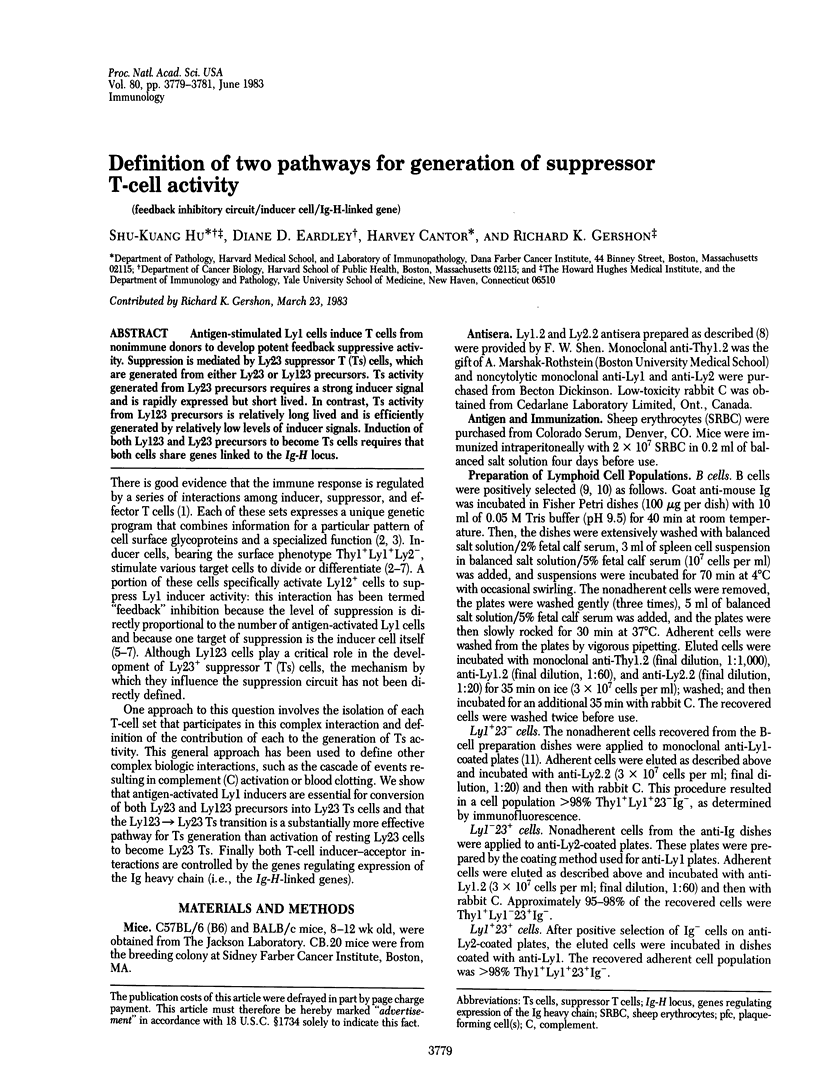Abstract
Antigen-stimulated Ly1 cells induce T cells from nonimmune donors to develop potent feedback suppressive activity. Suppression is mediated by Ly23 suppressor T (Ts) cells, which are generated from either Ly23 or Ly123 precursors. Ts activity generated from Ly23 precursors requires a strong inducer signal and is rapidly expressed but short lived. In contrast, Ts activity from Ly123 precursors is relatively long lived and is efficiently generated by relatively low levels of inducer signals. Induction of both Ly123 and Ly23 precursors to become Ts cells requires that both cells share genes linked to the Ig-H locus.
Full text
PDF


Selected References
These references are in PubMed. This may not be the complete list of references from this article.
- Cantor H., Boyse E. A. Functional subclasses of T-lymphocytes bearing different Ly antigens. I. The generation of functionally distinct T-cell subclasses is a differentiative process independent of antigen. J Exp Med. 1975 Jun 1;141(6):1376–1389. doi: 10.1084/jem.141.6.1376. [DOI] [PMC free article] [PubMed] [Google Scholar]
- Cantor H., Gershon R. K. Immunological circuits: cellular composition. Fed Proc. 1979 Jun;38(7):2058–2064. [PubMed] [Google Scholar]
- Cantor H., Hugenberger J., McVay-Boudreau L., Eardley D. D., Kemp J., Shen F. W., Gershon R. K. Immunoregulatory circuits among T-cell sets. Identification of a subpopulation of T-helper cells that induces feedback inhibition. J Exp Med. 1978 Oct 1;148(4):871–877. doi: 10.1084/jem.148.4.871. [DOI] [PMC free article] [PubMed] [Google Scholar]
- Cantor H., McVay-Boudreau L., Hugenberger J., Naidorf K., Shen F. W., Gershon R. K. Immunoregulatory circuits among T-cell sets. II. Physiologic role of feedback inhibition in vivo: absence in NZB mice. J Exp Med. 1978 Apr 1;147(4):1116–1125. doi: 10.1084/jem.147.4.1116. [DOI] [PMC free article] [PubMed] [Google Scholar]
- Cantor H., Shen F. W., Boyse E. A. Separation of helper T cells from suppressor T cells expressing different Ly components. II. Activation by antigen: after immunization, antigen-specific suppressor and helper activities are mediated by distinct T-cell subclasses. J Exp Med. 1976 Jun 1;143(6):1391–1340. doi: 10.1084/jem.143.6.1391. [DOI] [PMC free article] [PubMed] [Google Scholar]
- Cunningham A. J., Szenberg A. Further improvements in the plaque technique for detecting single antibody-forming cells. Immunology. 1968 Apr;14(4):599–600. [PMC free article] [PubMed] [Google Scholar]
- Eardley D. D., Hugenberger J., McVay-Boudreau L., Shen F. W., Gershon R. K., Cantor H. Immunoregulatory circuits among T-cell sets. I. T-helper cells induce other T-cell sets to exert feedback inhibition. J Exp Med. 1978 Apr 1;147(4):1106–1115. doi: 10.1084/jem.147.4.1106. [DOI] [PMC free article] [PubMed] [Google Scholar]
- Eardley D. D., Shen F. W., Cantor H., Gershon R. K. Genetic control of immunoregulatory circuits. Genes linked to the Ig locus govern communication between regulatory T-cell sets. J Exp Med. 1979 Jul 1;150(1):44–50. doi: 10.1084/jem.150.1.44. [DOI] [PMC free article] [PubMed] [Google Scholar]
- Fresno M., Nabel G., McVay-Boudreau L., Furthmayer H., Cantor H. Antigen-specific T lymphocyte clones. I. Characterization of a T lymphocyte clone expressing antigen-specific suppressive activity. J Exp Med. 1981 May 1;153(5):1246–1259. doi: 10.1084/jem.153.5.1246. [DOI] [PMC free article] [PubMed] [Google Scholar]
- Huber B., Devinsky O., Gershon R. K., Cantor H. Cell-mediated immunity: delayed-type hypersensitivity and cytotoxic responses are mediated by different T-cell subclasses. J Exp Med. 1976 Jun 1;143(6):1534–1539. doi: 10.1084/jem.143.6.1534. [DOI] [PMC free article] [PubMed] [Google Scholar]
- Mage M. G., McHugh L. L., Rothstein T. L. Mouse lymphocytes with and without surface immunoglobulin: preparative scale separation in polystyrene tissue culture dishes coated with specifically purified anti-immunoglobulin. J Immunol Methods. 1977;15(1):47–56. doi: 10.1016/0022-1759(77)90016-3. [DOI] [PubMed] [Google Scholar]
- Mishell R. I., Dutton R. W. Immunization of dissociated spleen cell cultures from normal mice. J Exp Med. 1967 Sep 1;126(3):423–442. doi: 10.1084/jem.126.3.423. [DOI] [PMC free article] [PubMed] [Google Scholar]
- Wysocki L. J., Sato V. L. "Panning" for lymphocytes: a method for cell selection. Proc Natl Acad Sci U S A. 1978 Jun;75(6):2844–2848. doi: 10.1073/pnas.75.6.2844. [DOI] [PMC free article] [PubMed] [Google Scholar]
- Yamauchi K., Murphy D., Cantor H., Gershon R. K. Analysis of antigen-specific, Ig-restricted cell-free material made by I-J+ Ly-1 cells (Ly-1 TsiF) that induces Ly-2+ cells to express suppressive activity. Eur J Immunol. 1981 Nov;11(11):905–912. doi: 10.1002/eji.1830111110. [DOI] [PubMed] [Google Scholar]


